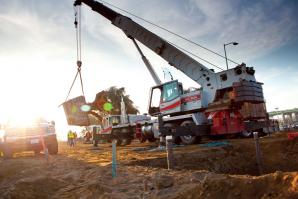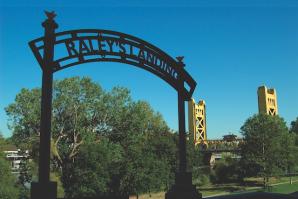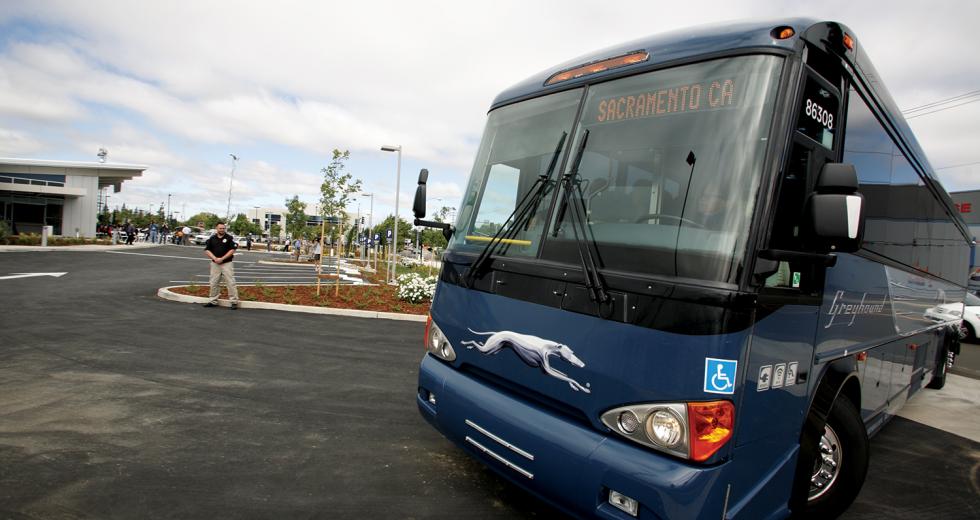When city of Sacramento leaders sat down in January 2008 to construct the River District Specific Plan, they had an ambitious goal: Take an industrial area with a high concentration of social services and turn it into a picturesque pedestrian- and bicycle-friendly community with housing, retail and office space — all while maintaining a welcoming atmosphere to everyone already there.
They also sought to balance an urban environment along 2.5 miles of riverfront with respect for its natural habitat, connect a physically isolated area to the rest of the city through new roads and public transit, and maximize opportunities for green energy and features.
It was a tall order that took three years to hash out, but on Feb. 15 the River District Specific Plan was passed by the Sacramento City Council with next to no opposition.
The plan also earned the city an award. In May, the Sacramento Valley American Planning Association gave it the Comprehensive Planning Large Jurisdiction Award. It’s now in the running for the statewide honor from California APA. Results will be announced in September.
“From the beginning we set out to create a plan that had this great vision but that we knew could be buildable,” says Greg Taylor, Community Development Department senior urban designer, who served as co-leader on the plan process with Rachel Hazlewood, senior project manager for the Economic Development Department. “We were able to make compromises to make sure it stayed within a realistic framework.”
The River District Specific Plan Area, a redevelopment area since 1990, is about 750 acres, bordered on the north by the American River, west by the Sacramento River, east by 16th Street and south by the Sacramento Railyards Specific Plan Area.
It’s home to about 5 million square feet of industrial uses, 384,000 square feet of retail, 1 million square feet of office and 400 homes.
The River District, the nonprofit association overseeing the fee-assessed business improvement district, is managed by Executive Director Patty Kleinknecht and 15 board members. The board is comprised of business, public agency and city representatives, who served as advisers throughout the specific plan process.
Guided by the city’s 2030 General Plan, the specific plan gives businesses an updated, tangible guide to follow on issues like street layout, zoning and land use, so there are no surprises, says board member Steve Ayers, CEO of Armour Steel Co., which has been in the district for 22 years. “They’ll know exactly what they can do on a piece of property,” Ayers says.
Balancing the needs of stakeholders wasn’t an easy task, but out of the more than 200 property owners, “four or five” came with concerns to the final hearing, Hazlewood says.
“I attribute that to about 40 public meetings and all the other meetings we had on an ongoing basis with individual property owners and developers,” she says.
Public workshops at the beginning of the process drew large crowds of residents, business owners, neighborhood associations, advocacy groups, social service providers and public agencies. Since spring 2008, many have continued giving feedback.
Over about the next 25 years, the River District envisioned in the specific plan is a vibrant, mixed-use community with roughly 8,000 homes, 4 million square feet of office, 800,000 square feet of retail, 1.4 million square feet of industrial, 3,000 hotel units and 55.5 acres of parks.
In this quest, some key projects are paving the way. More than $450 million, including about $100 million in public funds, has been invested in current and recent projects: the California Highway Patrol headquarters, Regional Transit’s new green line light-rail extension and station, Richards Boulevard/Interstate 5 interchange upgrades, the Township Nine development, the Powerhouse Science Center, the new Greyhound terminal, California Lottery headquarters and the Sacramento River Water Treatment Plant Rehabilitation Project.
“One of the game changers in the River District is the Powerhouse Science Center,” Ayers says. Set within the historic Pacific Gas & Electric Co. power plant building off Jibboom Street, this new home of the 60-year-old Discovery Museum Science & Space Center “is going to be a catalyst for not only the River District, but for the entire region,” Ayers says. In April it was awarded $7 million to pay for the first of three buildings in its $50 million museum.
Another game changer is the Regional Transit green line light-rail station at Richards Boulevard and North Seventh Street, set to open by early 2012. Eventually, a second station on Sequoia Pacific Boulevard will be built, and the line will extend to the Sacramento International Airport.
Perhaps the biggest catalyst is the 65-acre Township Nine development. Approved in 2007, it will bring about 2,350 homes, 840,000 square feet of office space, 140,000 square feet of retail and 20 acres of open space.
“It laid a lot of groundwork that we were able to build off of,” Taylor says. “Had it not been in place and approved, it would have made our process more of a challenge.”
Hazlewood agrees: “Once we had someone braving the territory, being the pioneers, we knew the market would be there. It will demonstrate that the plans are feasible. … It will say, ‘Guys, this is what the River District can be.’”
And Township Nine would not have been possible if North Seventh Street had not been connected with â?¨Seventh Street downtown, she says. This was the first of several planned street â?¨connections to other parts of the city.
The River District envisioned in the specific plan is a vibrant, mixed-use community with roughly 8,000 homes, 4 million square feet of office, 800,000 square feet of retail, 1.4 million square feet of industrial, 3,000 hotel units and 55.5 acres of parks.
“That set the stage for the progress occurring right now,” Hazlewood says. “Before that, the River District was very isolated. … The CHP wouldn’t have relocated here without that connection to downtown.”
A challenge was to balance a vision for a pedestrian-, cycling- and transit-friendly district with one that could be more easily accessed by car. Ayers says such easy access is key for business development. “That provides great opportunity for someone to come in,” he says.
Open space is another critical element in the plan. Parks will line the rivers’ edges and be dispersed throughout the district.
Building heights will transition eastward from tall structures along the Sacramento River to shorter ones along the American River with buildings spaced apart to allow clear river views.
A key concern has been the fate of the district’s industrial businesses. Simply put, the plan allows existing businesses to continue operating as usual in their same locations, but limits what new industrial businesses can move in.
“We wanted to create an environment in which those businesses that provide jobs and revenues for the city have a home and feel welcome to stay there,” Hazlewood says.
Taylor notes “a lot of those businesses are in some way servicing downtown, and their proximity is â?¨strategic and crucial for them and the city, so we don’t want to push them out.”
The plan includes a policy that a landlord with a businesses not matching up with the final zoning can replace a departing tenant with a similar type of business, without having to get planning commission approval.
“We’ve actually crafted the most lenient policy in the city for conditional uses and change of use,” Taylor says. “Since the whole district is a mixed-use district, it’s very flexible.”
Hazlewood says: “We’re not looking to homogenize the district. It will be eclectic. You will have a commercial enterprise maybe right next to a retail center. We think that will be part of the urban fabric and actually add interest to it.”
For inspiration, city staff looked at some Bay Area neighborhoods that have transitioned from industrial to mixed use.
“It’s exciting to be the first neighborhood in the Central Valley to take the approach that some of the communities in the Bay Area have taken,” Hazlewood says.
They acknowledge that as mixed-use areas evolve, some industrial businesses choose to leave, and that could happen in the River District.
Now about the only thing that could stand in the way of all the plans is money. The city estimates full buildout with roads and other infrastructure will cost about $323 million with some $180 million coming from developer fees.
While current infrastructure projects are funded, near-future projects, including crucial street improvements, rely in part on $25 million in redevelopment funds at potential risk if the current state budget plan to eliminate redevelopment agencies isn’t overturned in court.
“Losing those funds would be a tremendous loss,” Hazlewood says. “We’d either have to take certain plans out or postpone them for way down the road.”
Redevelopment funds also would be used to backfill price breaks on fees offered as a risk incentive for pioneer developers building during the first five years.
With or without the funds, city and business leaders are looking â?¨ahead.
“The River District has good bones to build on,” Hazlewood says. “I think people are going to be attracted to it because it’s extremely well located, and they’re going to see the potential of the river really start to shine.”
Taylor says: “For people who are looking for an exciting place that doesn’t have the traditional housing model, this is great. There’s access to the river and the bikeways, and over 95 percent of the district is within a 10-minute walk of transit stations. Plus, we’ve got large job bases already established with CHP, our city offices and the Lottery.”
“So we have things already started,” Hazlewood says. “We just need to polish them up.”
Recommended For You

Gateway to Growth
Redevelopment milestones in the Bridge District
On a breezy, blue-sky day in late November, West Sacramento city and regional planning officials gathered near Raley Field to celebrate the opening of Tower Bridge Gateway, a reconstructed boulevard connecting Highway 50 to Tower Bridge.

What the Waterfront
The evolution of West Sac’s shoreline
As a resident of fabulous West Sacramento, I was going to start this column with my standard opening line of “West Sac is the best Sac,” but flipping through the pages of our July ’92 issue, I found a quote from Val Toppenberg that said, “Cross-river bashing is not productive.” What a fun-killer.



